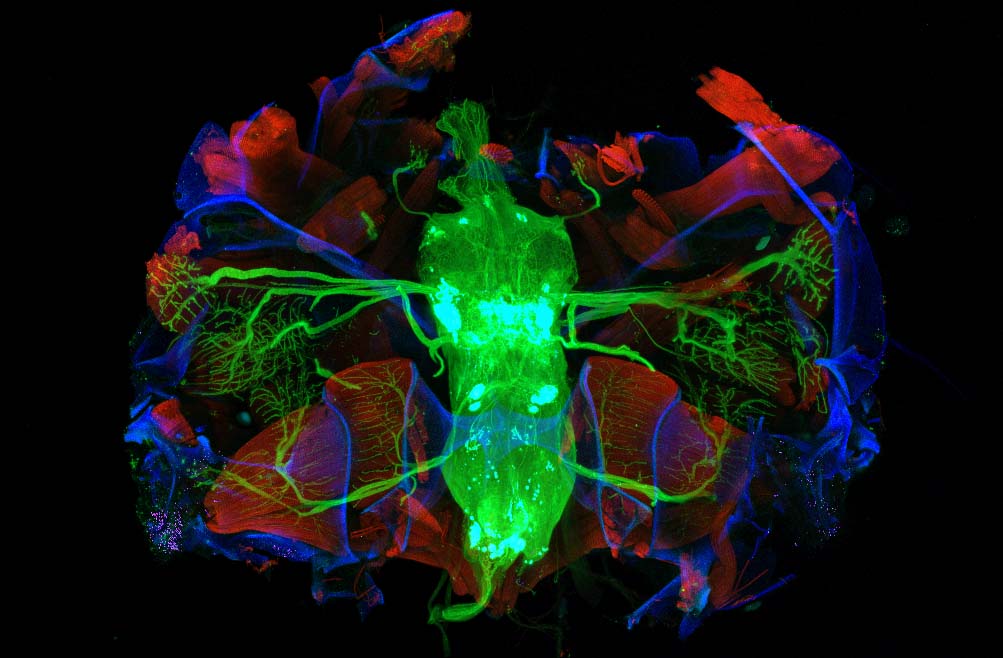Research
Background: Drosophila reproductive behaviour
When a Drosophila male meets a female, he typically displays courtship. He orients towards his mate, follows her, sings by vibrating his wing and attempts copulation. Courtship wing song is a highly structured, species-specific acoustic signal. It consists of alternating pulse and sine song. Song stimulates the receptivity of a virgin female and drives her to accept males for copulation. Although largely innate, sexual behaviour is not a rigid reflex, but is modulated by multiple external and internal factors, such as physiological state, behavioural context and social experience (for review, see Ellendersen and von Philipsborn 2017, Curr Opin Insect Sci 24).
Motor patterning and multifunctionality of motor systems
Multifunctionality of neuromuscular systems is widespread. Most motor neurons and muscles are used for different behaviours, subserving or participating in different pattern generating networks. This poses a challenge to underlying neuronal control. Mechanisms of neuronal control of multifunctional motor systems are of long standing interest for circuit neuroscience. They provide insight in the implementation of behavioural choice, selection and state dependent circuit reconfiguration.
We chose the wing motor control in Drosophila as an attractive model system for multifunctionality. Flight control and sexual acoustic signaling, i.e. generation of the male fly’s courtship song, both rely on precisely patterned wing movements. They employ a small set of wing muscles and corresponding motor neurons. We studied the neuronal control mechanisms of this multifunctional motor system by live imaging of muscle ensemble activity patterns during song and flight and establish the role of a comprehensive set of wing muscle motor neurons by functional manipulations. Song and flight rely on distinct configurations of neuromuscular activity, with most, but not all flight muscles and their corresponding motor neurons contributing to song and shaping its acoustic parameters. The two behaviours are exclusive, and the neuronal command for flight overrides the command for song. The neuromodulator octopamine is a candidate for selectively stabilizing flight, but not song motor patterns (O’Sullivan et al. 2018, Current Biology 28)
In contrast to multifunctional motor neurons, premotor interneurons seem to be dedicated to either song or flight control. A few types of interneurons expressing the sex-determination factors Fruitless (Fru) or Doublesex (Dsx) are reported to affect song structure (von Philipsborn et al. 2011, Neuron 69; Shirangi et al. 2016, Dev Cell 37), but little is known about how they interconnect and control the motor neurons.
By integrating data from genetic and neuronal screens we currently investigate how the song pattern is generated at the level of interneurons.
Discovery and characterization of Drosophila female copulation song
We discovered that female Drosophila sing by wing vibration in copula. This copulation song is distinct from male courtship song and requires neurons expressing the female sex determination factor DoublesexF. Copulation song depends on transfer of seminal fluid components of the male accessory gland. Playback of female copulation song to a mating couple increases the time the female takes to remate with subsequent males and thereby increases the reproductive success of the first male. This suggests that auditory cues from the female modulate male seminal fluid transfer (Kerwin et al. 2020, Nature Communications).
We hypothesize that female copulation song serves as a signal in postcopulatory mate choice, giving the female the opportunity to influence the composition and postmating effect of ejaculate (Kerwin and von Philipsborn 2020, BioEssays).
Our findings reveal an unexpected fine-tuning of reproductive decisions during a multimodal copulatory dialog. The discovery of a female-specific acoustic behavior sheds new light on Drosophila mating, sexual dimorphisms of neuronal circuits and the impact of seminal fluid molecules on nervous system and behavior. Further, our work sheds light on new mechanisms of sperm competition and postcopulatory (cryptic) female mate choice- phenomena that are widespread in most animal species, but very little studied from the perspective of underlying neuronal circuits.

